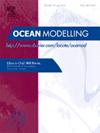西地中海高频雷达观测系统模拟试验。拉格朗日评价方法
IF 2.9
3区 地球科学
Q2 METEOROLOGY & ATMOSPHERIC SCIENCES
引用次数: 0
摘要
通过在伊比沙海峡(西地中海)的观测系统模拟实验(OSSE)评估了在HFR系统中纳入新天线的潜在影响。使用同一模型的两种不同配置:(i)自然运行被认为是真实的海洋状态,用于生成伪观测,以及(ii)控制运行,其中伪观测被同化。首先通过与以往观测系统实验(OSE)的比较验证了OSSE。新天线在两个不同时期对预测表面电流的影响进行了评估,在NR和CR之间的一致性程度不同。发现HFR扩展有助于显著纠正海峡环流模式,导致地面经向速度误差减少高达19%。利用OSSE提供的完整海洋状态信息,在拉格朗日框架下分析了该地区地面运输的改善。结果表明,数据分析可以更好地表征NR中存在的拉格朗日相干结构。本文章由计算机程序翻译,如有差异,请以英文原文为准。
High frequency radar observing system simulation experiment in the Western Mediterranean Sea. A Lagrangian assessment approach
The potential impact of the inclusion of new antenas in a HFR system is evaluated through an Observing System Simulation Experiment (OSSE) in the Ibiza Channel (Western Mediterranean Sea). Two different configurations of the same model are used: (i) a Nature Run considered as the real ocean state, is used to generate pseudo-observations, and (ii) a Control Run , where the pseudo-observations are assimilated. The OSSE is first validated by comparison against a previous Observing System Experiment (OSE). The impact of the new antennas for forecasting surface currents is evaluated in two different periods with different levels of agreement between NR and CR. The HFR expansion is found to contribute to significantly correct the circulation patterns in the Channel, leading to surface meridional velocity error reductions up to 19%. The improvement on surface transport in the area is analyzed in the Lagrangian framework, taking advantage of the full ocean state knowledge given by the OSSE. Results show that DA can help to better represent the Lagrangian Coherent Structures present in the NR.
求助全文
通过发布文献求助,成功后即可免费获取论文全文。
去求助
来源期刊

Ocean Modelling
地学-海洋学
CiteScore
5.50
自引率
9.40%
发文量
86
审稿时长
19.6 weeks
期刊介绍:
The main objective of Ocean Modelling is to provide rapid communication between those interested in ocean modelling, whether through direct observation, or through analytical, numerical or laboratory models, and including interactions between physical and biogeochemical or biological phenomena. Because of the intimate links between ocean and atmosphere, involvement of scientists interested in influences of either medium on the other is welcome. The journal has a wide scope and includes ocean-atmosphere interaction in various forms as well as pure ocean results. In addition to primary peer-reviewed papers, the journal provides review papers, preliminary communications, and discussions.
 求助内容:
求助内容: 应助结果提醒方式:
应助结果提醒方式:


